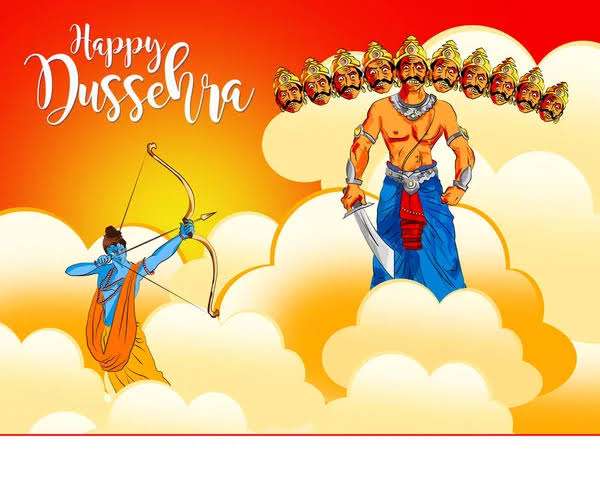Happy Vijayadashami ( Dussehra)– October 5, 2022, history, spiritual importance and More,
Vijaydashmi, or Dusshera is the 10th and the last day of Durga Puja; this year it’s October 5. All over India Hindus celebrate this auspicious day in many different ways. In some parts, it’s the day Goddess Durga killed the demon Mahishasur.
After nine days of Navratri, the festival culminates with the immersion of the idol of Durga. This was also the day King Rama, an avatar of Vishnu, killed Ravana, the 10-headed demon. To celebrate the legend huge effigies of Ravana are burned and with it burns all evil. Vijaydashmi’s the eternal promise that good will always vanquish evil.
WHEN IS VIJAYADASHAMI 2022?
Vijayadashami is celebrated every year at the end of Navaratri. The celebration is on the tenth day of the Hindu calendar month of Ashvin, which typically falls in September or October.
HISTORY OF VIJAYADASHAMI

Vijayadashami, or Dussehra, has several different stories related to it, with the common theme being the victory of good over evil.
It is often reported that the story of Rama’s victory over Ravana can be traced as far back as 5114 BC. This famous Hindu celebration says that the eighth incarnation of Lord Vishnu, Lord Rama, killed the ten-headed devil Ravana.
Lord Rama, along with his brother Larkshman and follower Hanuman, trekked to Ravana’s kingdom to fight him and bring back Sita, Rama’s wife. On their way Rama prayed to Durga and was eventually victorious.
It was from around 1500BC that the first Durga Puja celebrations are mentioned, with these in Dinajpur and Malda. These celebrations often draw upon Goddess Durga’s assassination of the demon Mahidhasur
VIJAYADASHAMI TIMELINE
5114 BC
The Story of Rama and Ravana
Many historians believe this is the date for Ramayana — the story of the life of King Rama.
1500 BC
The First Durga Puja Celebration
Landlords of Dinajpur and Malda organized the first formal Durga Puja celebration.
2008
UNESCO recognized the performing arts
UNESCO inscribed the performance arts tradition during Vijaydashmi as an “Intangible Cultural Heritage of Humanity.”
VIJAYADASHAMI TRADITIONS
For some, Vijayadashami marks the end of Durga Puja and they remember the goddess Durga’s victory Mahishasura to restore and protect dharma. For others Vijayadashami remembers god Rama’s victory over Ravan.
Traditional ways to celebrate include processions to a river or ocean, during which people carry statues of Surga, Lakshmi, and Ganesha as they chant and listen to music. The festival also starts the preparations for Diwali (the festival of lights) which comes twenty days after Vijayadashami.
HOW TO OBSERVE VIJAYADASHAMI
Attend a Dusshera fair
During the fair you can enjoy displays of idols, foods, handicrafts, and the enactment of “Ram Leela.” Mostly all of them end with the ceremonial burning of a Ravana effigy that might also include a fireworks display!
Read the Ramayana
The epic Ramayana is available in many languages. It’s a fascinating story to read about the life of King Rama.
Visit a Hindu temple
During Vijaydashmi special events are held in temples that anyone can attend.
5 ENLIGHTENING FACTS ABOUT VIJAYDASHMI
Why the idols are immersed
Immersing the idol on Vijaydashmi symbolizes how a deity moves from the formless (clay) to form (the idol) and then again to formlessness in water — bringing a balance to nature and cosmic energy.
Kullu Dusshera is famous
The Kullu Dusshera of Himachal Pradesh in India is an international festival where 500,000 people from all over the world come to participate in the festivities.
The real battle is inside us
Most importantly Vijaydashmi is about spiritual growth. There is a battle between good and evil inside each one of us and we must strive to conquer the inner negativity.
Asoka became a Buddhist on this day
The great conqueror Asoka converted to Buddhism on Vijaydashmi — vowing never to lift a weapon again.
Why Ravana had 10 heads
Ravana’s 10 heads represent his knowledge of the six “Shastras” and the four “Vedas.” But some say they stand for the 10 human vices that we must symbolically burn in our quest for salvation.
WHY VIJAYADASHAMI IS IMPORTANT
It celebrates the victory of good over evil
It reaffirms our faith in the fact that evil cannot win and that a divine power is watching over us.
It’s a time for spiritual awareness
Rama killing Ravana is symbolic too — with Ravana’s 10 heads representing 10 human vices. This is a time to pray and conquer our weaknesses.
It’s an auspicious day to begin anything new
In many parts of southern India young children are introduced to learning on this day. In fact it is a great day to begin any project.



